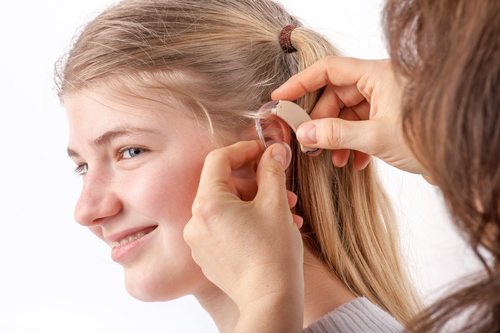You can’t underestimate the importance of communication: the imparting or exchanging of information. Through conversation, we can connect with the people around us. We can meet new people, foster friendships, express our opinions, share important news, and so much more. When hearing loss makes it difficult to take part in conversations, your personal life and professional life may suffer. Hearing loss can even put your safety at risk, as it increases the odds that you’ll miss audible signals of impending danger. Unfortunately, some people find it hard to admit that they are having trouble hearing. Understanding how hearing aids work can make it easier to embrace this life-changing technology.
Before we discuss how hearing aids work, we need to review the process of hearing.
Sound waves are a type of energy caused by vibration. In someone with normal hearing, these waves are collected by the outer ear and funneled into the ear canal. There, they cause the ear drum to vibrate. Three tiny bones inside your ear – the hammer, anvil, and stapes – transmit these vibrations to the cochlea, a snail-shaped organ that is filled with fluid and tiny hairs called cilia. As the sound vibrations agitate the fluid, the cilia detect the vibrations and convert them into electrical signals that the brain processes.
Hearing might seem instantaneous, but it a multistep process, so there are many places where things can go wrong. When disease, aging, or an injury cause damage to the small sensory cells in the inner ear, sounds need to be louder to be heard. This is called sensorineural hearing loss, and people living with this condition often find that wearing a hearing aid can be incredibly helpful.
When performers speak into a microphone, massive speakers amplify their voices so that their audience can hear them. Hearing aids work in much the same way. Despite their small size, they combine a microphone, amplifier, speaker, and the battery that runs them in a discreet, wearable unit.
Basically, when you wear a hearing aid, the sound waves that travel toward your ear are picked up by the hearing aid’s microphone and converted into a signal. The amplifier increases the signal’s strength, and this boosted signal travels to a miniature speaker. The speaker plays the sound at an increased volume, sending it down the ear canal to the inner ear, and the ear’s natural mechanisms take it from there.
Hearing aids come in a variety styles, including all of the following:
- Behind the Ear (BTE): A BTE hearing aid features a plastic case worn behind the ear that is connected by a thin tube to a plastic earmold that sits just inside the outer ear. The electronics occupy the case behind the ear and funnel the increased volume through the tube to the earmold.
- In the Ear (ITE): An ITE hearing aid places all the necessary components inside a hard plastic case that fits in the outer ear. They are generally suitable for adults with mild to severe hearing loss. Because the case would need to be continually resized for a proper fit, it is rare for this style of hearing aid to be recommended for children.
- In the Canal (ITC): An ITC hearing aid tucks mostly inside the ear canal and is carefully fitted to the unique size and shape of the wearer’s ear canal. Since the small size limits its power, this style of hearing aid is not a good choice for individuals with hearing loss that ranges from severe to profound.
- Completely in the Canal (CIC): A CIC hearing aid is virtually invisible since it nestles inside the ear canal. Like an ITC hearing aid, its size limits its power, so it is only suitable for those with mild to moderately severe hearing loss. Their tiny stature can also make these devices challenging to adjust and remove, so it is vital that anyone opting for this type of hearing aid be fitted by an experienced audiologist.




